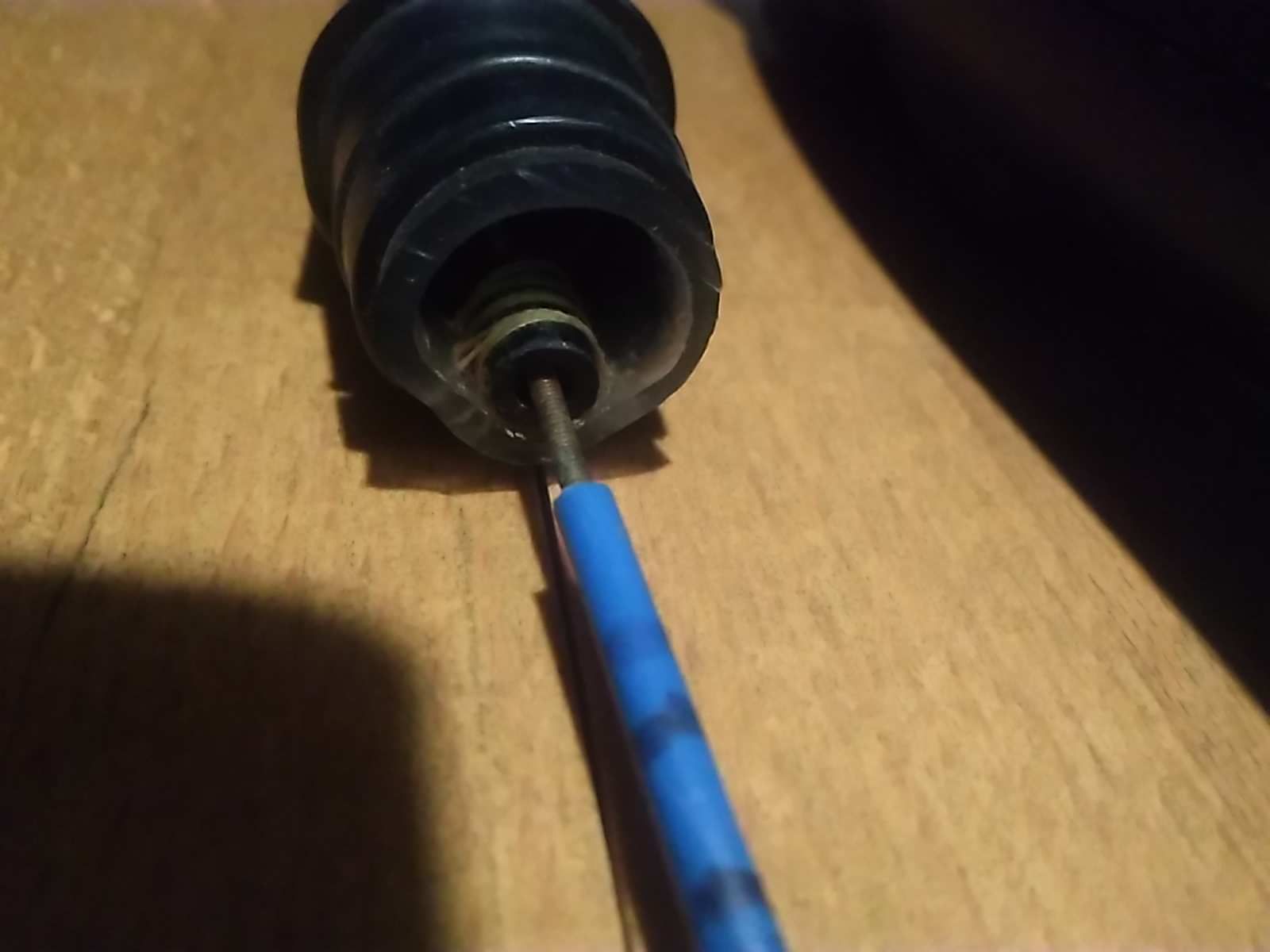Mouthpiece Mod to reduce Moisture
-
Wondering if anyone has experimented with or thought about a modification to the Sylphyo Mouthpiece to reduce moisture into the instrument.
I'm thinking of maybe an inserted component into the South end of the current mouthpiece (the large opening) that would catch and store condensation until it can be cleared.
I'm handy with a 3D printer, but most 3D filament material is not suitable for mouth contact (the microscopic pits in the surface make for bacteria condominiums).
-
Never heard of such a modification. Not for any wind instrument. Could be an invention.
-
An S-shaped curved mouthpiece with a water flap.
-
Milling grooves inside and inserting absorbent material? Problem with drying/replacement.
-
Drill holes in the sides and insert absorbent pins, according to the method "1/3 absorbent surface is 1/3 less condensation"? Problem with drying/replacement.
-
Insert a thin-walled sleeve with a rough surface and hope that condensation does not occur there. But then where does it take place and does the rough surface do anything to the airflow? A paper sleeve would do the trick, as long as it doesn't occur to her to play herself ...
-
Mill blind holes in the inside so that less condensation occurs and moisture remains trapped longer. Is the inevitable airflow turbulence unfavourable?
-
Heat the mouthpiece, the upper part, or the whole tube of the sylphyo to human saliva temperature to avoid condesation. Maybe Aodyo can put in a stronger processor that heats quite incidentally :-)
-
Make a request to NASA.
-
-
@Peter-Ostry Great springboard ideas!
Some Native American flutes have such contrivances.
Basically I'm thinking of making a pocket / reservoir inside the mouthpiece at the gravitational bottom of the mouthpiece (in normal playing position) to catch condensate for later occasional clearing by removing the mouthpiece (every 30 minutes?)
Playing a lot these days (and nights) and want to avoid moisture issues ... with a Blues band the other night ...

-
Are you sure that the condensate is disciplined enough to follow gravity and flow into the area where you can comfortably collect it, despite the strong airflow?
Maybe you need an "all-around pocket", an inset second wall, an inner tube with minimal upper gap into which to blow the condensate.
But any pocket in there will give turbulence. If you look into the main tube of the Sylphyo from above, you will see (feel) a very smooth, flat transition where the mouthpiece connects. I imagine they did that for a reason, because strong turbulence could support sensor flutter.
That's why I think your design should be very streamlined. If some droplets enthusiastically take advantage of that to jump over the pocket along with the air, that's fine too.
As a test, perhaps a ring would be suitable, which you insert into the mouthpiece at various points to see if anything at all collects there that is worth to drain off.
-
@Clint Have you considered fitting a USB rechargable fan to the Sylphyo. I was wondering what a fan at the bottom blowing up into the Sylphyo would do to the breath control... and mobility?? .. or this? https://www.ebay.com.au/itm/294118356438?hash=item447ad1f5d6:g:bxkAAOSwaFNgdPGB&amdata=enc%3AAQAHAAAAoISpy1KRyutzk5ty%2BGlhSw1UmUymiC0UlovTF5gjv0ij2uEiS7xG3No%2FLjHALJx0Mu4GcyRb7wt9T7FDWgT39H5QWaDVdHVosvUO2bjPObLTBe%2B4GKbrhYHXK%2BcgEw%2BxZt4iPLl3DpmgZsgAUzk284%2B7QnuRzeAxi%2Fv8DK19SWfpAnq2VgSA0UKV1jTlAOWV6r8dN5FQl7VpVMOXnqdqNzM%3D|tkp%3ABk9SR6anr9_HYQ
-
I have been contacted by a very experienced flute maker and Sylphyo owner - Edward Kort - who has been following this discussion (but cannot respond here because he has yet to be able to get his forum membership approved).
He has successfully experimented with using a porous, hydrophilic (water-loving) insert into the standard Sylphyo mouthpiece. The material is a specialized polyethylene, treated with a surfactant to absorb moisture up to about 40% of its volume.
He reports good results - reducing his usual time-to-first-drip out of the bottom of the Sylphyo from "a few minutes" to "nary a drop after 30 minutes".
He is sending me a sample (arriving in a week) for testing.
Here are some images he sent me:

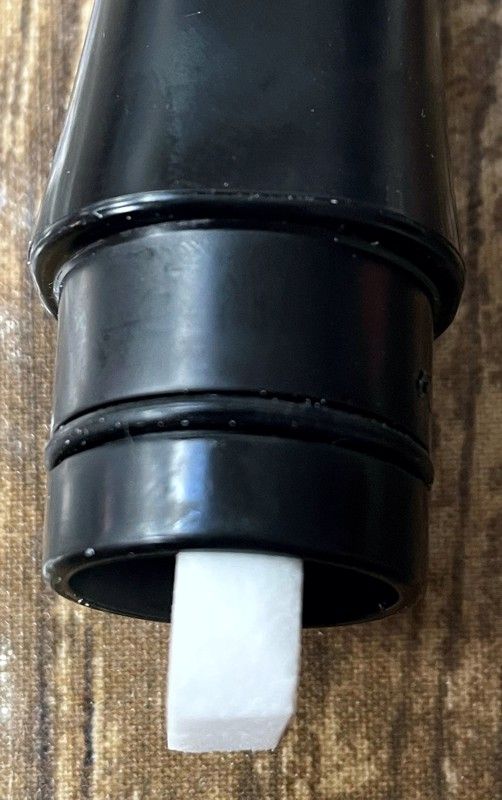
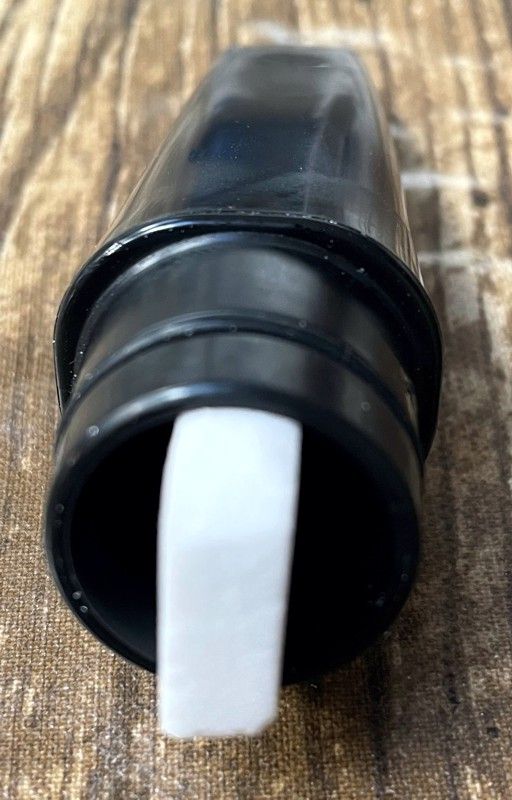
He sourced the material from Scientific Commodities. The particular material he is sending me is from a 10 micron, 1/4" thick sheet (Cat #BB2062-10BL) that can be found on this page:
https://scicominc.com/porous-plastics/porous-sheets/
... however, for our purposes, I am looking at the possibility of using their porous tubes ... something like Cat #BB2062-5075A1L from this page:
-
Not sure if that scicominc material is the right stuff, but you will find out. Hydrophobic does not like water, Hydrophilic filters water, we don't want either. If it really works, this may be because of changed circumstances for condensation inside the mouthpiece. But then almost any material with a porous surface should work. And what about the airflow?
Regarding the tubes and if the material works – they don’t offer the dimension we need on their website.
—
Have you tried to roll one layer of a thin kitchen sponge into the mouthpiece? I don't know how it is called in your country, we call it 'Wettex' which is a company label.
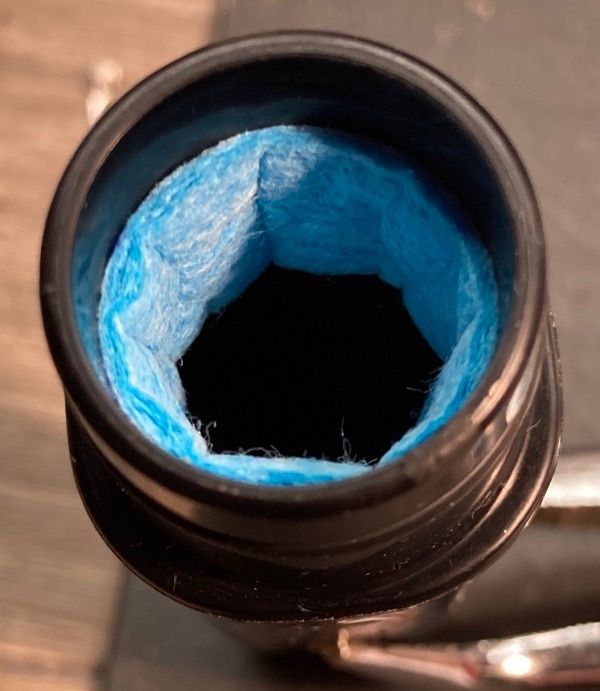
This is just my first try. I think the "tube" should be a little longer and maybe we have to make sure that we don't blow the whole thing into the Sylphyo’s main tube. An elastic ring that holds it in place? The material definitely absorbs liquid, that's its job, and it costs nearly nothing.
-
Wow, Clint, you are reading my mind!
What exactly are your symptoms? In other words, what problems are being caused?
For my part, I'll notice a bubbling sensation. It's weird, but it doesn't seem to affect the tone in any way. Because of that I suspect the problem is happening at the bottom tube plug - water gathers and fills the little hole of the plug.
What I've done in this case is to always have two plugs and two mouthpieces and swap them out when one gets too wet. But I'm panicked that I'll drop the tube plug and it will get lost on a dark stage!
I mean, this kind of thing has always been a problem with wind players (as I'm sure you know), Usually, people don't mind taking a break while someone swabs out their instrument.
Would also be worried about blowing the thing down the tube, but "nary a drop" sounds really good :)
Search "hydrophilic" on Amazon and you get something else that might work - here
-
Hello there,
I'm concerned with this problem and personally, I let a recorder swab inside the sylphyo while playing. Sounds weird but it has many advantages: nice feedback and pressure sensation. (no need of plug and precise setting... see below)
If you have a second swab nearby, you can change it quickly in a middle of a concert.
3rd advantage: each time you stop playing, you remove the mouth piece and its attached swab: your sylphyo is ready to dry fast, most of the humidity is on the woolly swab. Yes, the swab stem is attached to the mouth piece.At last, I exchanged the swab stem by a 1.5mm threaded rod that is screwed into a 1.5mm nut witch is fixed inside the mouthpiece. Thanks of that, I can screw or unscrew to set the amount of pressure the swap push on the end of the wind tube. And so, you can set the wind feedback really precisely.
Last improvement would be to 3D print a better system to fix the 1.5mm nut into the mouthpiece because for the moment it's the only thing not so convincing of my sylphyo...
Have a nice music !
MatPS: if you really search for a water absorbant for wind instrument, I would definitely go to the bagpipe system called "water trap"
-
@mathiross It would be great to get a few photos of your setup ...
-
-
@mathiross said in Mouthpiece Mod to reduce Moisture:
I'm playing the sylphyo in the new progressive rock band ODDLEAF. Take a look here: https://oddleaf.net
Wow ... I love this music. Kinda jazzy progrock, if this designation is allowed. I like the overall vibe, the people, the voicing, harmonies, tempo changes, careful selection and usage of instruments, everything. Thank you for showing me this!
-
@Peter-Ostry said in Mouthpiece Mod to reduce Moisture:
Wow ... I love this music. Kinda jazzy progrock, if this designation is allowed. I like the overall vibe, the people, the voicing, harmonies, tempo changes, careful selection and usage of instruments, everything. Thank you for showing me this!
Shared with the rest of the band, thanks a lot ! 💖
-
I have been working for several weeks now with some samples of a porous, hydrophilic material sent to me by flutemaker Edward Kort. They are custom cut from a 1/4" thick sheet with 10 micron pores supplied by Scientific Commodities (Cat #BB2062-10BL) that can be found on this page: https://scicominc.com/porous-plastics/porous-sheets/. Photos are shown in the earlier message in this thread.
My experience so far has be very positive. The material is easy to insert and remove from the standard Sylphyo mouthpiece. It does not cause a noticeable change in playing characteristics. The insert absorbs a substantial amount of moisture holds it, and dries out when removed (I typically dry it overnight).
The inside of my Sylphyo has gone from “large moisture droplets on the inside walls of the Sylphyo which coalesce and drip out the bottom” without the hydrophilic inserts to “light dew / haze on the inside walls” with the insert.
I am still on the road so can’t do a more detailed study (like weighing the insert before-and-after to determine the amount of moisture absorbed).
One concern is how oil (e.g. from handling the insert with fingers) might affect the long-term performance of the insert. There is apparently no remedy for hydrophilic material that gets clogged with oil. I am hoping that with reasonably careful handling (by the edges and just the area at the distal end of the insert), an insert might last a year or more. Edward Kort’s philosophy is (personal email) “make a pile and replace as necessary. It’s easy to check the condition of an insert: hold it to your lips and blow. If you can’t move any air, trash the insert.”
I was also concerned about possible shedding of fibers. Edward Kort’s feeling is that “I’ve never seen any fiber shedding; this would be a very bad characteristic in an industrial filter material. That said, the cut edges are feathery – probably due to the nature of the pore structure. With my NAF application (with the insert in the bird), I want the flue-exit end to be very smooth. I accomplish this by masking the surface of the plastic and apply CA glue just to the end. This end can then be smoothed and shaped. Works great, but it is an effort to implement. For the Sylphyo application, I don’t see any reason to seal the ends.”
He has also tried several variations:
I use two formulations of the plastic: the 10-micron pore style that I sent you, and a 30 micron pore size. The 30-micron product is much harder than the 10. It is not spongy at all and seems a bit more durable. However, it must be sawed rather than cut, and it contracts a bit when wet. This requires me to glue the insert into the bird channel, whereas the 10-micron product can just be press fit.
When I get back home (4 months on the road so far – great experience and somewhat exhausting. Just did a concert last night …) I hope to delve more into these inserts …
-
Just posted a video on hydrophilic inserts for the Sylphyo.
This video is an excerpt from a longer video on moisture relating to Native American flutes that will be published in a few months.
Source for porous hydrophilic plastic:
Scientific Commodities – SciComInc.com
Sheets: 10 micron, 1/4" thick sheet – Cat #BB2062-10BL
Tubes: ¾” OD x ½” ID Cat #BB2062-5075A1L -
I have been doing some testing today with the tubular version of the hydrophilic plastic that is shown in the video ... and it does not seem to absorb as much as the simple flat piece of the same material.
I think there is less surface area on the inside of the tube than the two-sided flat surfaces of the rectangular version.
-
@Clint Nice. I am a "wet player" too :)
In the video you seem to imply you just leave the insert in all the time. Do you ever have to pull it out to dry?I've also been playing with this idea and am using this stuff from Amazon: https://www.amazon.com/gp/product/B08ZHZS1W6/ref=ppx_yo_dt_b_search_asin_title?ie=UTF8&psc=1
The box is much cheaper than your alternative ($14). My wife, the nurse, showed me this - normally used for wound dressing (!) But each insert gets soaked, so I change once per day.
I cut off a piece, twist into a tube and insert.
(It's amazing how this thing in the mouthpiece makes no appreciable effect on the wind resistance. Can't do that so easily with regular wind instruments! It's fun to ignore the laws of physics... :)
-
@wwoodard8 Forgot to mention - it works great with absorbing water. No burbling sounds, dripping etc...
-
@wwoodard8 thanks! I just picked up a pack of these
-
I'm glad I registered to this community. I also had concerns about moisture in thw Sylphyo, read this thread and ordered these medical compresses from A. for a few €. They doe not lint and leave no fibers and hold back a good amount of moisture up to 1 hour of playing at usual room temperature.
I cut one "sheet" to 7,5 x 5 cm, made a roll, put it in the mouthpiece so that about 3 cm go into the moutpiece an 2 cm go into the Sylphyos housing. So cheap that you can change it as often as needed,
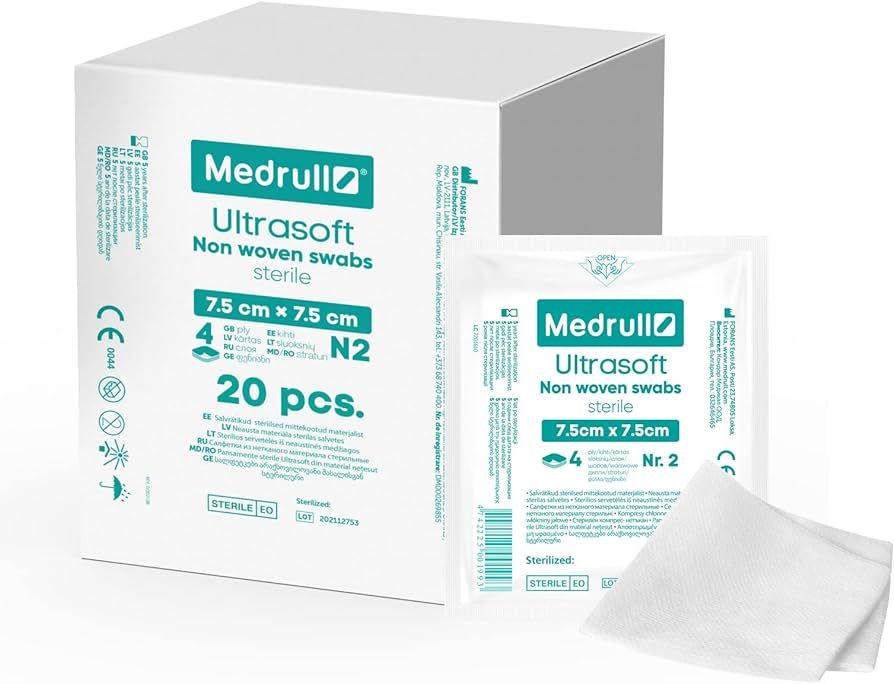
-
@grommi said in Mouthpiece Mod to reduce Moisture:
I'm glad I registered to this community. I also had concerns about moisture in thw Sylphyo, read this thread and ordered these medical compresses from A. for a few €. They doe not lint and leave no fibers and hold back a good amount of moisture up to 1 hour of playing at usual room temperature.
I cut one "sheet" to 7,5 x 5 cm, made a roll, put it in the mouthpiece so that about 3 cm go into the moutpiece an 2 cm go into the Sylphyos housing. So cheap that you can change it as often as needed,

Hello for my part I slide a small roll of paper towel like handkerchief or paper towel inside the tip and it does the job very well and almost free ;) it changes absolutely nothing to the breath or the dynamics of Sylphyo

